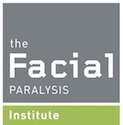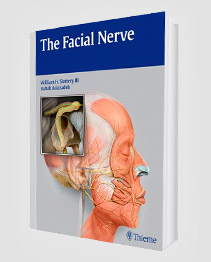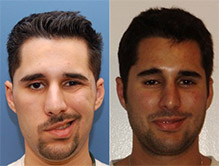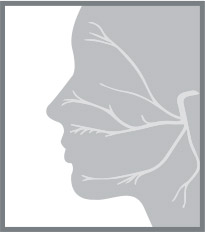Congenital facial nerve paralysis can affect a child starting at birth, and its impact can be significant. Kids can experience physical side effects due to congenital facial nerve palsy, along with emotional issues that can affect their self-confidence and ability to connect with others.
For children who display symptoms of congenital facial paralysis, immediate diagnosis and treatment is crucial. Because, if facial paralysis symptoms linger, they can cause long-lasting problems that continue into adulthood.
Dr. Babak Azizzadeh of The Facial Paralysis Institute treats facial paralysis in children and adults. He is world-renowned for his expertise in performing facial plastic and reconstructive surgery and head and neck surgery and tailors each treatment to his patient. With his extensive approach to treatment of congenital facial paralysis, Dr. Azizzadeh can help a patient alleviate their facial paralysis symptoms at any age.
What Are the Symptoms of Congenital Facial Nerve Paralysis?
Congenital facial nerve palsy symptoms can include:
- Drooping of one side of the face
- Difficulty speaking clearly
- Asymmetrical facial appearance
- Drooling
- Inability to fully open or close the eye
The symptoms of congenital facial paralysis vary, and they can impact a child’s ability to speak, eat, and make facial expressions. They can also affect a child’s mental and emotional wellbeing.
How Can Congenital Facial Nerve Palsy Impact a Child’s Mental and Emotional Wellbeing?
Congenital facial nerve paralysis can dramatically alter a child’s appearance. In this instance, a child may feel increasingly self-conscious about their appearance.
For example, some kids coping with congenital facial nerve palsy struggle to make friends and foster meaningful relationships with others. In these instances, congenital facial paralysis can lead children to isolate from others, as well as contribute to the development of depression, anxiety, and other mood disorders.
Also, kids dealing with facial paralysis can feel ashamed or embarrassed about their facial appearance. This can lead to teasing and cause children to withdraw from social activities.
At the first sign of facial paralysis symptoms in a child, a parent should immediately provide reassurance. Medical treatment options are available to address facial paralysis in kids. A parent who explores all available treatment options can help their child address their facial paralysis symptoms in their early stages.
What Causes Congenital Facial Paralysis?
There are many reasons why children experience congenital facial nerve palsy, including:
1. Bell’s Palsy
Pediatric Bell’s palsy can cause facial weakness, drooping of the corner of one side of the mouth, and other facial paralysis symptoms. In many instances, Bell’s palsy symptoms disappear on their own. But, if Bell’s palsy symptoms persist beyond three months of onset, a child could be dealing with congenital facial nerve palsy.
2. Moebius Syndrome
Moebius syndrome is a neurological condition that causes congenital facial weakness and makes it difficult to move the eyes away from the nose. Some research indicates that Moebius syndrome is present in approximately one out of every 50,000 births in the United States, according to the National Organization of Rare Disorders (NORD). In addition, research shows that congenital facial nerve palsy can be a symptom of Moebius syndrome.
3. Perinatal Trauma
Research indicates that perinatal trauma is one of the most-common causes of congenital facial nerve paralysis. Perinatal risk factors linked to congenital facial nerve palsy include a high birth weight, the use of forceps during birth, and delivery via cesarean section.
During a medical evaluation, a child’s congenital facial nerve paralysis symptoms are reviewed closely to provide an accurate diagnosis. If a child is diagnosed with congenital facial paralysis, appropriate treatment options are then explored.
How Is Facial Paralysis in Children Diagnosed?
For children, a medical evaluation for congenital facial nerve paralysis involves an examination of a patient’s symptoms, their severity, and whether one or both sides of the face are paralyzed. The evaluation can also include blood tests, X-rays, and magnetic resonance imaging (MRI) or computed tomography (CT) scans of the patient’s head.
What Congenital Facial Nerve Paralysis Surgeries Are Available?
If a patient is diagnosed with congenital facial nerve palsy, several surgical treatments are available. These include:
1. Temporalis Tendon Transfer
With a temporalis transfer, a patient’s temporalis muscle is transferred from the scalp to the corner of the mouth. The patient then undergoes neuromuscular retraining after surgery to regain the ability to make natural facial expressions over time.
Patients who undergo temporalis transfer surgery can achieve dynamic reanimation of the facial muscles, as well as improve facial symmetry. Research also indicates that temporalis transfer patients frequently report positive postoperative surgery results.
2. Gracilis Muscle Transplant
A gracilis muscle transplant requires the transfer of a muscle from a patient’s inner thigh to facial muscles that are no longer functional. The procedure may be recommended for patients coping with congenital facial paralysis that persists for two years or longer.
During a gracilis muscle transplant procedure, a small incision is made in front of a patient’s ear. Next, fat and skin is lifted from the patient’s cheek, and the gracilis muscle and its associated blood vessels and nerve are transferred to the patient’s face. Then, the patient can improve their facial muscle strength within about six to 12 months of a gracilis muscle transplant.
3. Masseter to Facial Nerve Transfer
A masseter to facial nerve transfer is designed to improve facial reanimation in congenital facial nerve paralysis patients and patients dealing with permanent Bell’s palsy or complete facial paralysis. The procedure can also be beneficial for patients coping with facial paralysis symptoms for three years or fewer.
Like a gracilis muscle transplant procedure, a masseter to facial nerve transfer begins with an incision made in front of a patient’s ear. The patient’s facial and masseteric nerves are then sewn together. This helps restore the patient’s facial muscle function, and it enables the patient to naturally smile, frown, and produce other facial expressions.
Are Non-Surgical Treatments Available to Address Facial Paralysis in Kids?
Botox can be used to help adult patients treat facial paralysis symptoms. At least one study indicates Botox can also help restore lip symmetry in kids dealing with facial paralysis.
In the study, researchers performed a review of medical records of 18 children with facial paralysis treated with Botox from 2004 to 2012. They measured the lower lip symmetry in patients’ smiling photographs before and after treatment.
Researchers found that Botox can improve facial symmetry in children coping with facial paralysis symptoms. And, they did not observe any complications in kids who received Botox for facial paralysis.
Along with Botox, corticosteroids can be used to treat facial paralysis in kids. Research shows that corticosteroids can reduce facial paralysis symptoms in children within three days of onset.
Safety concerns persist about the use of Botox and corticosteroids to treat facial paralysis in children. As such, a full evaluation of children who display facial paralysis symptoms is necessary. This evaluation involves a review of a patient’s facial paralysis symptoms and medical history. It enables a doctor to determine if Botox injections or corticosteroids are safe, effective options to help a patient alleviate their symptoms.
Can Congenital Facial Nerve Paralysis Symptoms Disappear on Their Own?
Congenital facial nerve palsy symptoms can linger for an extended period of time. They won’t disappear on their own and must be treated accordingly.
In the event that a child displays facial paralysis symptoms, bring him or her to a doctor. This allows a child to undergo a medical evaluation and provides their parent with insights into why these symptoms are occurring. It also ensures that a child can receive a proper diagnosis and begin a facial paralysis treatment program.
How to Help a Child Cope with the Mental and Emotional Side Effects of Congenital Facial Nerve Palsy
Facial paralysis in children can occur in conjunction with mood disorders. As a child undergoes treatment for congenital facial nerve palsy, it is important for a parent to watch for mental and emotional side effects.
It may take several weeks or months before a patient sees the full results of treatment for congenital facial paralysis. During this time, a parent can support their child in several ways.
For a parent, it can be beneficial to share details about their child’s facial paralysis treatment with school counselors, teachers, and coaches. This can help school personnel work with a child to ensure that he or she receives as much support as possible throughout their treatment.
A parent can help their child plan for situations in which he or she may be asked about their facial paralysis symptoms. Generally, prepared responses can help a child become confident in their ability to answer questions about their facial paralysis.
Parents should keep the lines of communication open with their children over the course of a facial paralysis treatment. Kids should feel comfortable coming to their parents with any concerns or questions during treatment.
If parents feel their children require additional support during a facial paralysis treatment, they can have their kids meet with a mental health professional. Kids can receive counseling, so they can develop and implement healthy strategies to manage with the mental and emotional side effects of facial paralysis.
Which Treatment Option for Facial Paralysis in Children Delivers the Best Results?
The ideal treatment for congenital facial nerve paralysis in a child depends on the classification of a patient’s condition and other factors. By meeting with Dr. Azizzadeh, a child can undergo a comprehensive evaluation, then receive a personalized treatment.
Dr. Azizzadeh recommends treatment of congenital facial paralysis in children as early as possible. Along with the physical impact of congenital facial paralysis on a child’s facial appearance, the condition can cause emotional issues.
Ultimately, Dr. Azizzadeh wants to help kids treat congenital facial nerve paralysis symptoms quickly and safely. To achieve the best results of treatment, Dr. Azizzadeh learns about a child and their facial paralysis symptoms. Dr. Azizzadeh next develops a custom treatment to accommodate his patient and ensure the patient can address their symptoms now and in the future.
Once Dr. Azizzadeh provides treatment for congenital facial nerve palsy, he stays in contact with his patient. Dr. Azizzadeh requests follow-up appointments, so he can track his patient’s progress in the weeks and months following a congenital facial paralysis procedure. If a patient or their parents have any concerns or questions after treatment, Dr. Azizzadeh is available to respond to them as well.
Schedule a Congenital Facial Nerve Paralysis Treatment Consultation with Dr. Azizzadeh
Parents who are concerned that their children may be dealing with congenital facial paralysis can set up a treatment consultation with Dr. Azizzadeh. To learn more or to schedule a consultation with Dr. Azizzadeh, please contact us online or call us today at (310) 657-2203.
Request your consultation with Dr. Azizzadeh today
Call us at (310) 657-2203 to schedule an appointment.
Schedule a Consultation




